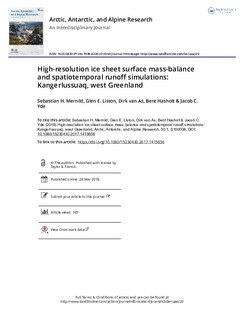| dc.contributor.author | Mernild, Jacob Sebastian Haugaard | |
| dc.contributor.author | Liston, Glen E. | |
| dc.contributor.author | van As, Dirk | |
| dc.contributor.author | Hasholt, Bent | |
| dc.contributor.author | Yde, Jacob C. | |
| dc.coverage.spatial | Greenland | nb_NO |
| dc.date.accessioned | 2019-01-25T10:08:08Z | |
| dc.date.available | 2019-01-25T10:08:08Z | |
| dc.date.created | 2018-06-13T10:33:55Z | |
| dc.date.issued | 2018 | |
| dc.identifier.citation | Mernild, S. H., Liston, G. E., van As, D., Hasholt, B., & Yde, J. C. (2018). High-resolution ice sheet surface mass-balance and spatiotemporal runoff simulations: Kangerlussuaq, west Greenland. Arctic, Antarctic, and Alpine Research, 50(1). | nb_NO |
| dc.identifier.issn | 1523-0430 | |
| dc.identifier.uri | http://hdl.handle.net/11250/2582312 | |
| dc.description.abstract | The spatiotemporal distribution of freshwater runoff from the Greenland Ice Sheet (GrIS) determines the hydrographic and circulation conditions in Greenlandic fjords. The distribution of GrIS first-order atmospheric forcings, surface mass-balance (SMB), including snow/ice melt, and freshwater river discharge from the Kangerlussuaq drainage catchment were simulated for the thirty-five-year period 1979/1980–2013/2014. ERA-Interim (ERA-I) products, together with the modeling software package SnowModel, were used with relatively high-resolutions of 3-h time steps and 5-km horizontal grid increments. SnowModel simulated and downscaled grid mean annual air temperature (MAAT) and SMB correspond well to point observations along a weather station transect (the K-transect). On average, simulated catchment runoff was, however, overestimated and subsequently adjusted against observed runoff. This overestimation could likely be because of missing multiyear firn processes, such as nonlinear meltwater retention, percolation blocked by ice layers, and refreezing. In the GrIS Kangerlussuaq catchment, the simulated thirty-five-year MAAT was −15.0 ± 1.4°C, with a mean 0° isotherm below 280 m a.s.l. near the ice sheet margin. At the ice sheet margin, on average, 45 percent of precipitation fell as snow. At 2,000 m a.s.l., snow constituted 98 percent of the total precipitation. At the catchment outlet of Watson River draining into the fjord Kangerlussuaq, 80 percent of the simulated runoff originated from GrIS ice melt, 15 percent from snowmelt, and 5 percent from rain. | nb_NO |
| dc.language.iso | eng | nb_NO |
| dc.publisher | Taylor & Francis | nb_NO |
| dc.rights | Navngivelse 4.0 Internasjonal | * |
| dc.rights.uri | http://creativecommons.org/licenses/by/4.0/deed.no | * |
| dc.subject | surface mass-balance | nb_NO |
| dc.subject | SnowModel | nb_NO |
| dc.subject | HydroFlow | nb_NO |
| dc.subject | Greenland Ice Sheet | nb_NO |
| dc.subject | freshwater runoff | nb_NO |
| dc.subject | ERA-I | nb_NO |
| dc.title | High-resolution ice sheet surface mass-balance and spatiotemporal runoff simulations: Kangerlussaq, West Greenland | nb_NO |
| dc.type | Journal article | nb_NO |
| dc.type | Peer reviewed | nb_NO |
| dc.description.version | publishedVersion | nb_NO |
| dc.rights.holder | © The authors. | nb_NO |
| dc.subject.nsi | VDP::Matematikk og Naturvitenskap: 400::Geofag: 450::Kvartærgeologi, glasiologi: 465 | nb_NO |
| dc.source.volume | 50 | nb_NO |
| dc.source.journal | Arctic, Antarctic and Alpine research | nb_NO |
| dc.source.issue | 1 | nb_NO |
| dc.identifier.doi | 10.1080/15230430.2017.1415856 | |
| dc.identifier.cristin | 1590900 | |
| cristin.unitcode | 203,0,0,0 | |
| cristin.unitname | Høgskulen på Vestlandet | |
| cristin.ispublished | true | |
| cristin.fulltext | original | |
| cristin.qualitycode | 1 | |

